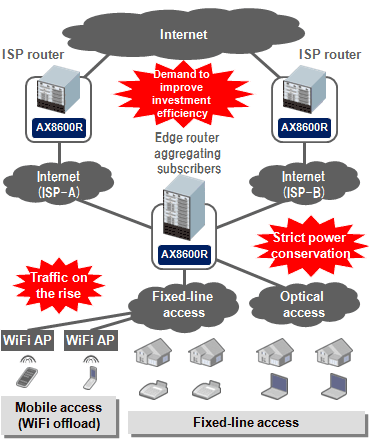In the current ISP networks, we must challenge the explosive growth of traffic at low CAPEX/OPEX. The wide-spread use of LTE-supporting mobile devices, such as smart phones, is rapidly increasing the demand for further enriched contents, causing ISPs to continue expanding their facilities. Under such circumstances, network devices must be scalable enough to achieve flexible system upgrade, automation of operations, etc. The ALAXALA AX series provides a communication infrastructure that addresses these issues.
Challenges facing ISP networks
- Handling increasing traffic at low CAPEX/OPEX
System planning foreseeing future traffic growth
Traffic flowing on networks has been on the rise. As the growth rate of traffic is also affected by OTT (Over the Top) services (services not provided by ISPs, such as video, voice chat, messengers), estimating such growth is difficult. Further, estimating the future increase of full internet routes is also difficult, given the various factors affecting the growth (e.g., population of IPv6, depletion of IPv4 addresses, selling / buying of addresses).
Due to such difficulty in estimating future traffic growth, ISPs select and operate their network devices considering the system expansion 5-10 years ahead. Whether replacing devices every year or purchasing high-end models foreseeing the needs 10 years ahead, investment efficiency is low, thus making on-demand functional upgrade an important issue.
The AX8600R series employs architecture that enables operation with a maximum of 6.4Tbps switching capacity between a modular type forwarding engine and a network interface card (NIF). By mounting a forwarding engine / NIF according to the amount of traffic or the number of physical ports, facility investment can be done effectively.
Further, by replacing a modular type switching unit or a forwarding engine, you can enhance switch performance and use 400G/1T Ethernet. Even if there are not enough slots remaining for forwarding engines/NIFs, you can enhance switch performance with a minimum investment just by upgrading modules.
The AX8600R series can provide enough route entry capacity even for dual stack operation (a maximum of 1.8 million IPv4 routes and 0.9 million IPv6 routes). Considering that it can presently accommodate approx. 0.5 million full-route entries for IPv4 and approx. 0.015 million full-route entries for IPv6 (based on the study August 2013), you can easily handle increasing routing paths. Moreover, by changing the distribution pattern of IPv4/IPv6 route entries via non-stop online service (#) and / or upgrading a forwarding engine module, you can flexibly upgrade switch performance according to the number of routing paths.
Compact body allowing flexible enhancement of port density
In ISPs generally, various types of lines are used, such as those for user traffic, network maintenance / operation, peering, etc. In the legacy type devices, when each line requires its own NIF, we need to add not only a NIF but also a forwarding engine suitable for the NIF, thus increasing the number of necessary forwarding engines and investment costs as well. Further, insufficient rack space due to the use of large-sized devices is also an issue we need to address.
The AX8600R series supports NIFs having 1/4-sized slots, which makes it possible to use four types of NIFs together on a single forwarding engine. With this unique micro line card structure, the AX8600R series enables gradual enhancement of port density and effective use of various types of physical lines.
With its compactness and large line accommodation capacity, the AX8600R series can significantly enhance investment efficiency in terms of cost / rack space.
Automation of operation management
Simplifying the time-consuming daily routine tasks (e.g., setting up new user accounts) significantly reduces OPEX.
To meet this demand from ISPs, the AX8600R series supports Script (#) and Configuration Template.
Script is a function for automatically performing the action corresponding to each event generated in a device, based on user definition using a script language (Python). Since the operation management for network devices is a sequence of event-driven procedures, Script is useful when automating these procedures in a manner suited to a system used in each ISP.
Configuration Template makes it possible to define a template configuration for adding new user accounts, for example. Unlike the conventional method in which you need to use multiple CLI commands when defining various parts of a device, Configuration Template allows you to apply the same template to every configuration setting to simplify configuration operations.
Such automation and simplification of operation management tasks reduce OPEX and operation errors as well, bringing great benefits to users.
Environment-friendly network devices
Due to the strict power conservation mandate in recent years, transmitting a large volume of traffic with less electricity is also a big challenge facing ISPs.
In the AX8600R series, cutting edge semiconductor technologies are used to reduce the amount of power consumed per Gbps. Further, Flexible Power Saving (#), which enables granular control of power consumption based on traffic volume, will be supported in future.
In addition, each model employs front-to-back airflow, making itself compliant with the standard air-conditioning design ( hot aisle / cold aisle arrangement ) adopted by each data center, contributing to the reduction of power consumption.
(#) To be supported in future.
Network configuration image

Routers
- AX8600R Series
-
100 Gigabit Ethernet high-end routers playing leading roles in networking strategies
(Scalable switching capacity, micro-line card structure, full internet routes, Flexible Power Saving, automation of operations)



